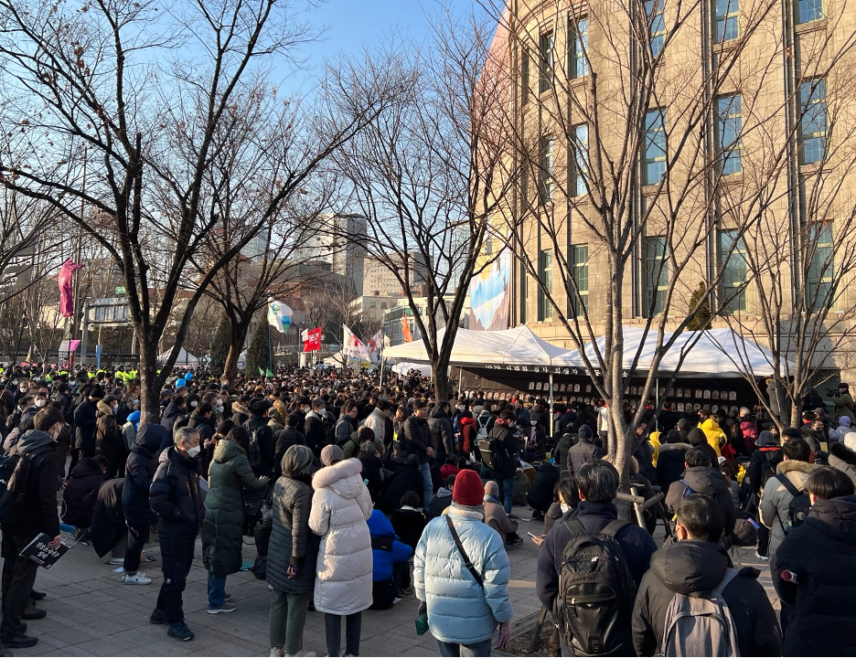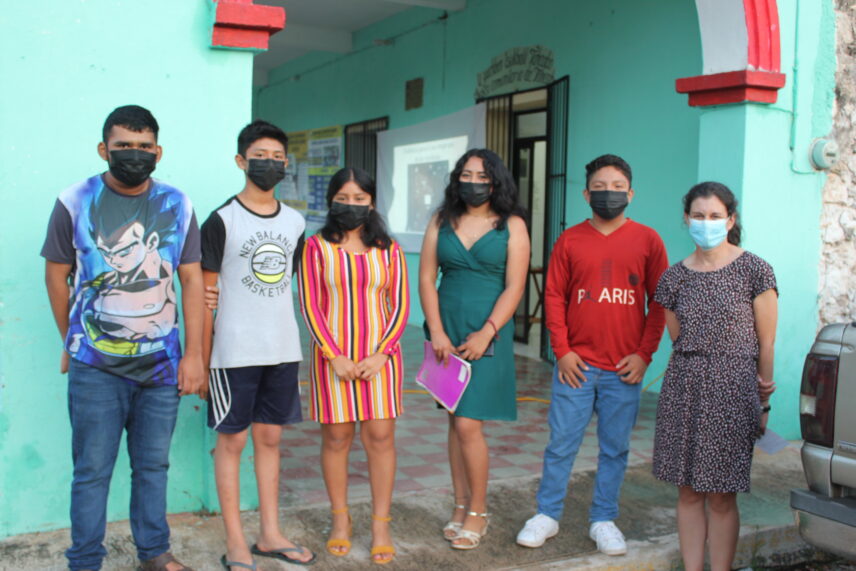
Following the 2022 Halloween crush disaster in Seoul, South Koreans gather to remember the young victims and the nation’s history of human-made disasters and formations of publics in furious mourning. The post Youth, Disaster, and Collective Mourning in South...
On the eve of December 16, 2022, thousands of people filled the main street of Itaewon, a former US camp town in Seoul, South Korea. My husband and I were standing among the assembled, feeling the temperature drop far below the freezing point as gusts of wind rushed through town. The town has a long history of foreign military occupation, transnational exchange of goods and fashion, and festivities that, like Halloween, inspire creative self-expression in public and a sense of belonging among young people. We were gathered in memory of those who were crushed to death on the night of October 29, 2022, in a narrow alley that shoots off of the one on which we were standing; 152 were injured, 159 died, including a teenage survivor who committed suicide. Most of the crowd crush victims were in their teens and 20s, out with friends on Halloween weekend. December 16 marked the 49th day of mourning for the lives lost—a day believed to be the last day spent by the spirits of the dead among the living before their final departure to the yonder. Throughout the history of contemporary South Korea, collective mourning in the streets for the wrongful deaths of youths has been central to the social and spatial materialization of publics, that is, assemblies of stranger-others woken to the reality of their common fate as citizens subject to state violence. Earlier on the morning of December 16, select family members of the crush victims had held a memorial service at a Buddhist temple, just north of Itaewon. The ritual had come to an end by burning the name tags of the lost in a metal pit amid the sounds of cries, bells, and monks chanting. About 300 of the family members then relocated to Itaewon, wrapped in red scarves to symbolize the blood of their kin to continue the memorial service among thousands of other citizens in the main street of the town. When the clock hit 6:34 p.m.—the officially recorded time of the first emergency call made to the local police on the eve of the disaster warning of possible crush deaths—the crowd closed their eyes, lowering their heads in silence. On the screen set up at the head of the assembly appeared the words of the caller, her urgent voice ringing through town, followed by the victims’ names, their portraits, and messages of longing from their families and friends.
Up until the 49th day of mourning, people had to gather for weeks before a faceless and nameless altar set up by the South Korean government in front of the city hall in Seoul. The current administration, under Yoon Suk-Yeol, withheld the backgrounds of the victims from being publicized in the news media, making it difficult for the bereaved families to contact one another. The initial footage of the victims—lying side by side on the streets of Itaewon covered in white sheets—had evoked in me much older photos from the 1980s of youths murdered by the state under military dictatorship. While interrogation, torture, and murder of youth protesters by police had become a thing of the past in South Korea, the mass loss of young people continues as they fall victim to human-made disasters in the most ordinary spaces in their everyday lives.
But the Itaewon crush also brought back memories of another recent disaster that took hundreds of lives of young people. In mid-April 2014, a ferry capsized near the southwest coast of South Korea, drowning 304 people, including 250 high school students on a field trip. As the search and rescue was prolonged amid a lack of government response, the entire country watched innocent youths disappear into the abyss, broadcast real-time on television and on YouTube. Realizing how easily the lives of youths could be forsaken in a neoliberal democracy, without guns or tear gas, people gathered across the country to mourn for the victims who had been left to die at sea. In the aftermath of the 2022 crush disaster, publics formed again to collectively remember the victims’ names, faces, and histories.

South Koreans’ collective mourning for the young victims of state violence and human-made disasters has been long shaped by their experience of becoming witnesses. Mourners would stand in the streets, hear the names of the victims called out loud, one after the other, see their faces enlarged on screens, and shout, “The state was absent!” The assembled would bear witness to not only the fact that the lives taken away had once fully existed but also the very experience of collective mourning. Such an experience of becoming witnesses is crucial to revitalizing a public that embraces the pain of others and its roots in their shared fate of being citizens responsible for the democratically elected government and its actions.
The South Korean public’s rage has only intensified since their recognition of the government’s undeniable role in the unfolding of the crush disaster. The Yoon administration had set the large gathering of the youths at Itaewon on the weekend of Halloween celebration as a stage for what Yoon had called “a war on drugs,” replacing the crowd control police, once regularly dispatched to the town on such festive occasions, with police officers dressed in plainclothes for their undercover operation against drug trafficking and drug use. This “war on drugs” was engineered as a key strategy for empowering the authority of the former prosecutor-turned-politicians now heading the government and for legitimating their monopoly on executive powers. And the strategy has pivoted around the criminalization of innocent youths and their occupation of the street space.
Mourning to Remember
Now occupying the main street of Itaewon that had once invited young visitors was a public in furious mourning. “Memory has such strength,” said Ms. Choi Sun-Hwa, mother of one of the high school students lost at sea in 2014, as she stood on stage on December 16, 2022, wearing a yellow scarf around her neck, facing the family members of the crush victims who sat in the audience wrapped in red scarves. For months, makeshift spaces for commemorating the ferry disaster victims had filled public spaces across South Korean cities with yellow memorabilia symbolizing the youths left to drown just when their lives were about to bloom like the forsythia of spring (Kim 2018). The main street of Itaewon now cried red and yellow.
Joined by the choir group formed in memory of the ferry disaster victims, Ms. Choi began to sing “We Won’t Forget,” promising so to the victims of the crush disaster.
We will remember, surely and everything, so not one of you feels alone.
Such were the words of promise that had brought hundreds of thousands out into the streets, awakening a public powerful enough to charge the country’s legislative bodies with an exigent sense of duty to push through the country’s first ever impeachment process in 2017. The successful impeachment of President Park Kun-Hae (2013–2017) did not stop people from remembering the loss and their duty to remember. I still regularly spot yellow stickers on the backs of people’s cellphones or yellow ribbons hanging on people’s backpacks when traveling on public transportation. Ms. Kim Sunny, whom I have known for years, is no exception.

“The song was specifically written for the ferry disaster victims in 2014 by Yoon Min-Suk,” my husband whispered into my ear. He remembered Yoon Min-Suk from his college days in the mid-1980s, when the artist first started writing songs for an underground cultural movement organized as part of the student activism against the military dictatorship. The song’s promise to remember has now been stretched to address the victims of the crush disaster. Those who were young adults in the tumultuous years of the 1980s, including Ms. Kim and my husband, came of age by bearing witness to the murders of youths under the military dictatorship (Lee 2009). Adopted new roles as parents, this generation now sees their children living in an era of the state’s dereliction and abuse of power. Publics in South Korea are constituted through this chain of collective mourning, where memories of the wrongfully dead youths get interwoven across generations through colorful mantras, objects, shapes, and lyrics. This mode of coexistence has persisted against and through times of collective upheavals. Their memories of the victims and of mourning together while embodying a public resistant to forgetting and forsaking the country’s youth dwell in the most ordinary spaces, shapes, and sounds—from all things yellow and red, to the very word “memory”—beyond the spectacular moments of such a public’s materialization in space.

Jieun Cho and Aaron Su are contributing editors for the SEAA section in Anthropology News. This piece is part of the SEAA series “The Future of the ‘Public’ in East Asia.” Contact them at jieun.cho@duke.edu and aaronsu@princeton.edu.
The post Youth, Disaster, and Collective Mourning in South Korea appeared first on Anthropology News.










